The Impact of Oil Viscosity on Your Vehicle in Cold Weather
As winter approaches, it's crucial to consider the effects of oil viscosity on your vehicle's...
Tires are the number one safety feature on your vehicle. Having a bit of knowledge can help in your decision of what tires are right for you. With wearable components such as tires, it is important to be educated on how different brands, ratings, and expected mileage can affect your safety and you'll feel it in your ride.
When it comes to choosing tires for your vehicle there are a lot of things to consider. Many elements factor in, we've but together a complete buying guide for your reference.
You could drive the priciest performance car out there, but if its tires are substandard, your ride will be substandard too — not to mention potentially dangerous. Most people don’t think much about their tires until a dashboard light indicates they’re low on air, they discover one is flat or they’re riding along and have a blowout. The best way to protect against this last worst case scenario is routinely inspecting your tires for wear and damage.
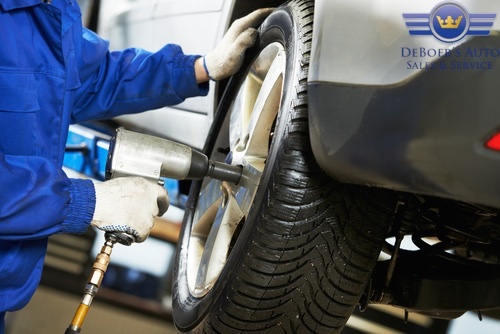
The lifespan of your tires depends on their quality, your driving habits, the climate and the road conditions they’re subjected to. Here are some general rules of thumb, though:
Unless you are an automotive professional, visually inspecting your tire tread may leave you questioning if it’s sufficient. One quick and easy way to evaluate your tread is to use a graduated tread depth gauge. These inexpensive tools are available at most auto parts stores. Simply place the probe into a groove in your tire, press the edges of the probe flat against the tire, and read the measurement. If tread measures less than 4/32”, it's time to replace the tires. For best traction in snow, replace at 6/32.
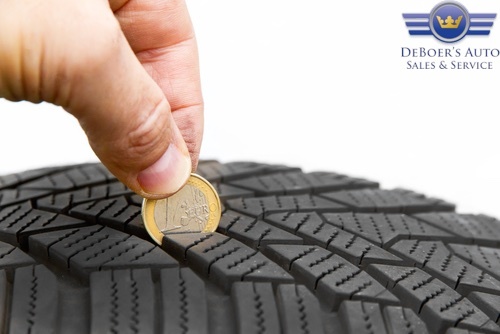
When you’re driving in slick road conditions, does your vehicle tend to hydroplane or skid more than it used to? Have you been in an accident or a close call that required you to suddenly slam on your brakes? Has it been awhile since you’ve replaced your tires and your car has been parked outside where it was subjected to an unusually hot summer or cold winter? Have you noticed it's more difficult to handle your vehicle when you're driving in snowy or wet conditions?
If your tires are more than 10 years old or have shallow tread, it’s time to start thinking about buying new tires sooner rather than later. Not only is it dangerous to drive on worn treads, but it might even be illegal.
Tire shopping can be a daunting prospect for people who have no idea how to tell one tire from the next. What size tires do you need? Can you get by with an economy version or should you invest in high-performance wheels? Coming up, look for our follow-up blog that will provide tips on how to tire shop.
In the meantime, if you’ve got questions about this or any other automotive topic, contact us at DeBoer’s Auto. We want you to count on us as your go-to source for all your automotive needs.
They’re black, round, your car needs four of them (plus a spare) and sometimes they need to be replaced. That sums up many peoples’ knowledge of tires. If the sea of options at your local tire shop is overwhelming and the meaning of the letters and numbers on your car’s tire walls is a mystery to you, read on to learn how to decipher the information found on your tires. Once you know what the information means, you’ll find it much easier to shop for new tires.
If you’re unsure how to locate the vehicle tire information you need or where to find your car’s tire size, look at your tire’s sidewall. For illustrative purposes, assume it says P185/75R 14 82S. Here’s what that means.
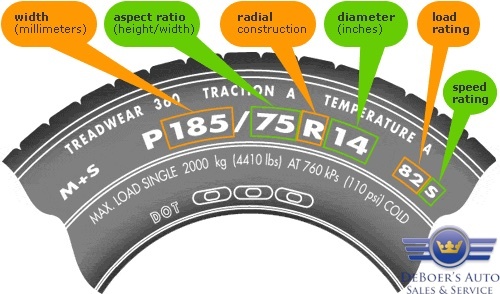
Besides your tires’ sidewalls, you’ll find helpful information about your tires on a sticker inside your driver’s side door. Usually, you’ll find your car’s maximum cargo weight, tire size and ideal tire air pressure listed.
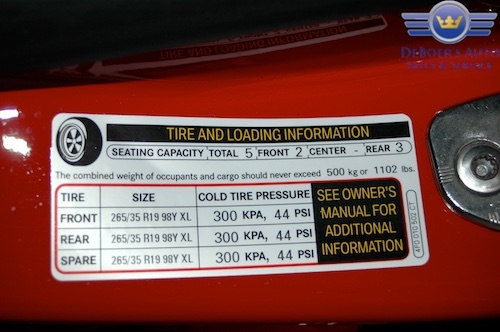
Besides knowing which size tires you’ll need, you also need to decide whether to buy original equipment (OE) tires or if an aftermarket version is acceptable. Some performance vehicle makers, such as Mercedes-Benz, BMW, Porsche and Audi, have created tires designed specifically for their brands. These are denoted by the markings MO; a star symbol; NO, N1, N2, N3 and N4; and AO, respectively, for the aforementioned brands. For the best performance, it’s wise to spend a bit more for these specialty OE tires.
If you have questions about which tires will best fit your vehicle’s needs and your driving habits, we invite you to contact us at DeBoer’s Auto. As a partner in the complete care of your vehicle, we’re happy to help.

If you’re like most drivers, your knowledge about vehicle tires is limited. However, when it comes time to replace the tires on your car or truck, knowledge is power. Before you go tire shopping, take time to evaluate your driving habits, the environmental conditions your tires likely will be subjected to and your budget. The adage, “you get what you pay for,” certainly applies to tires. Sure, even the cheapest tires will suffice to get you from point A to point B, but skimping on quality will affect your ride quality and, more importantly, your ability to adeptly handle your vehicle.

Since choosing the right tire improves the ride and handling of your car, it’s in your best interest to select wisely. Before you tire shop, you’ll need to know the basic tire specifications for your vehicle, such as tire type, size, speed rating and load capacity, for example. (Consult our blog posts, “How to Tire Shop - Steps 1 and 2” for specifics.) Beyond these basics, know which of the following tires best suit your driving habits.
Your ideal tires will depend on your percentage of highway driving versus more aggressive driving conditions. If your priority is to achieve outstanding comfort and handling, touring tires may be your best option. If you drive a sports car and wish to maximize performance, high-performance tires fit the bill. If you drive an SUV, begin your search in the SUV tire section. Many drivers who have trucks, prefer all terrain tires for better traction in different driving conditions.
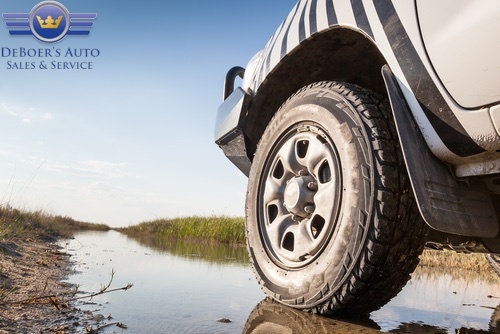
One of the most puzzling predicaments many tire shoppers face is whether they need snow or winter tires. Contrary to popular belief, there is a difference between snow tires and winter tires. That difference has to do with traction. Winter tires feature a knobby exterior tread designed to power through slushy mud and snow. Snow tires (you’ll see a snowflake symbol on a tire’s sidewall) have been certified by the American Society for Testing and Materials to achieve superior scores on traction tests. (Snow tires’ traction scores are 110-plus as compared to 100 scores for all-purpose tires.) This extra traction is especially beneficial when driving in severe winter weather characterized by slick, packed snow. Do you need snow tires or winter tires? That depends on how much snow falls in your area and how long it stays on the ground. It is all determined by how cold it gets where you live.
If you’re located in Sussex County and will be buying new tires soon, contact us at DeBoer’s Auto. We’ll help you select the ideal tires for your car and driving habits, and sell them to you at the lowest available price. We also have Road Hazard Protection available.
As winter approaches, it's crucial to consider the effects of oil viscosity on your vehicle's...